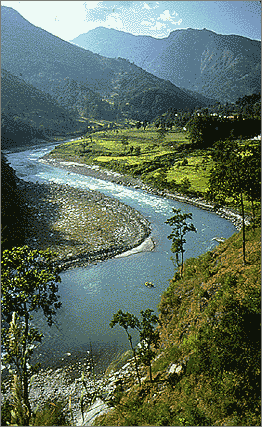Kalimpong Travel Guide:

Introduction
Kalimpong is a hill station in the Mahabharat Range (or Lesser Himalaya) in the Indian state of West Bengal. It is located at an average elevation of 1,250 metres (4,101 ft). The town is the headquarters of the Kalimpong subdivision, a part of the district of Darjeeling. The Indian Army's 27 Mountain Division is located on the outskirts of the town.
Kalimpong is known for its educational institutions many of which were established during the British colonial period. It used to be a gateway in the trade between Tibet and India prior to China's annexation of Tibet and the Sino-Indian War. Kalimpong and neighbouring Darjeeling were major centres calling for a separate Gorkhaland state in the 1980s.There has been a Rotary club in Kalimpong since 1993.
Kalimpong, located on a ridge overlooking River Teesta, is a tourist destination owing to its temperate climate and proximity to popular tourist locations in the region. Horticulture is also important to Kalimpong: it has a flower market notable for its wide array of orchids; nurseries, which export Himalayan grown flower bulbs, tubers and rhizomes, contribute to the economy of Kalimpong. Home to ethnic Nepalis, indigenous ethnic groups and non-native migrants from other parts of India, the town also is a religious centre of Buddhism. The Buddhist monastery Zang Dhok Palri Phodang holds a number of rare Tibetan Buddhist scriptures
History
Until the mid-19th century, the area around Kalimpong was ruled in succession by the Sikkimese and Bhutanese kingdoms. Under Sikkimese rule, the area was known as Dalingkot. In 1706, the king of Bhutan won this territory from the Sikkimese monarch and renamed it Kalimpong.[9] Overlooking the Teesta Valley, Kalimpong is believed to have once been the forward position of the Bhutanese in the 18th century. The area was sparsely populated by the indigenous Lepcha community and migrant Bhutia and Limbu tribes. Later in 1780, the Gorkhas invaded and conquered Kalimpong. After the Anglo-Bhutan War in 1864, the Treaty of Sinchula (1865) was signed, in which Bhutanese held territory east of the Teesta River was ceded to the British East India Company. At that time, Kalimpong was a hamlet, with only two or three families known to reside there. The first recorded mention of the town was a fleeting reference made that year by Ashley Eden, a government official with the Bengal Civil Service. Kalimpong was added to district of Darjeeling in 1866. In 1866–1867 an Anglo-Bhutanese commission demarcated the common boundaries between the two, thereby giving shape to the Kalimpong subdivision and the Darjeeling district
Transport
Kalimpong is located off the National Highway 31A (NH31A), which links Sevok to Gangtok. The NH31A is an offshoot of the NH 31, which connects Sevok to Siliguri. These two National Highways together, via Sevok, links Kalimpong to the plains. Regular bus services and hired vehicles connect Kalimpong with Siliguri and the neighbouring towns of Kurseong, Darjeeling and Gangtok. Four wheel drives are popular means of transport, as they can easily navigate the steep slopes in the region. However, road communication often get disrupted in the monsoons due to landslides. Within the town, people usually travel by foot. Residents also use bicycle, two-wheelers and hired taxis for travelling short distances.
The nearest airport is in Bagdogra near Siliguri, located about 80 kilometres (50 mi) from Kalimpong. Indian Airlines, Jet Airways, Air Deccan and Druk Air (Bhutan) are the three major carriers that connect the airport to Delhi, Calcutta , Paro (Bhutan) , Guwahati and Bangkok (Thailand). The closest major railway station is New Jalpaiguri, located on the outskirts of Siliguri, which is connected with almost all major cities of the country.
People and culture
The majority of the populace are ethnic Nepali, having migrated to Kalimpong in search of jobs while it was under British rule. Indigenous ethnic groups include the Newars, Lepchas, Bhutia, Sherpas, Limbus, Rais, Magars, Gurungs, Tamangs, Yolmos, Bhujels, Sunuwars, Sarkis, Damais and the Kamis.[49] The other non-native communities are the Bengalis, Marwaris, Anglo-Indian, Chinese, Biharis and Tibetans who escaped to Kalimpong after fleeing the Communist Chinese invasion of Tibet. Kalimpong is home to Trinley Thaye Dorje—one of the 17th Karmapa incarnations.[50] Kalimpong is the closest Indian town to Bhutan's western border, and has a small number of Bhutanese nationals residing here. Hinduism is the largest religion followed by Buddhism and Christianity. Islam has a minuscule presence in this region, mostly Tibetan Muslims who fled in 1959 after Chinese invasion of Tibet. The Buddhist monastery Zang Dhok Palri Phodang holds a number of rare Tibetan Buddhist scriptures.[4] There is a mosque in the bazaar area of Kalimpong.
Popular festivals include Diwali, Christmas, Dussera or dasain in the local nepali dialect and the Buddhist festival of Losar. Languages spoken in Kalimpong include Nepali, which is the predominant language; Lepcha, Limbu, Tamang, Kirat, Hindi, English and Bengali. Though there is a growing interest in cricket as a winter sport in Darjeeling Hills, football still remains the most popular sport in Kalimpong. Every year since 1947, the Independence Shield Football Tournament is organized here as part of the two-day long Independence Day celebrations. Former captain of India national football team, Pem Dorjee hails from Kalimpong. A popular snack in Kalimpong is the momo, steamed dumplings made up of pork, beef or vegetable cooked in a wrapping of flour and served with watery soup. Wai-Wai is a packaged snack made of noodles which are eaten either dry or in soup form. Churpee, a kind of hard cheese made from yak's or chauri's (a hybrid of yak and cattle) milk, is sometimes chewed. A form of noodle called Thukpa, served in soup form is also popular in Kalimpong.[57] There are a large number of restaurants which offer a wide variety of cuisines, ranging from Indian to continental, to cater to the tourists. Tea is the most popular beverage in Kalimpong, procured from the famed Darjeeling tea gardens. Kalimpong also has a golf course besides Kalimpong Circuit House.